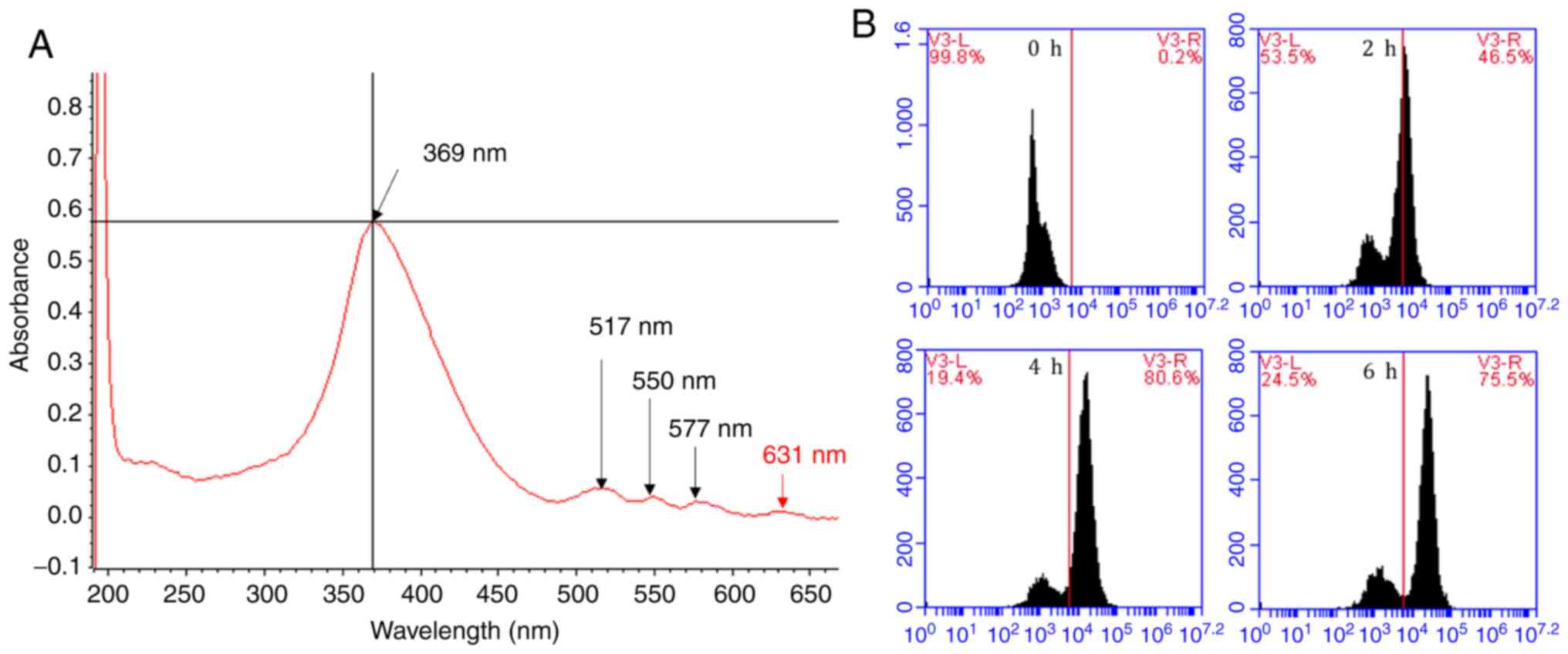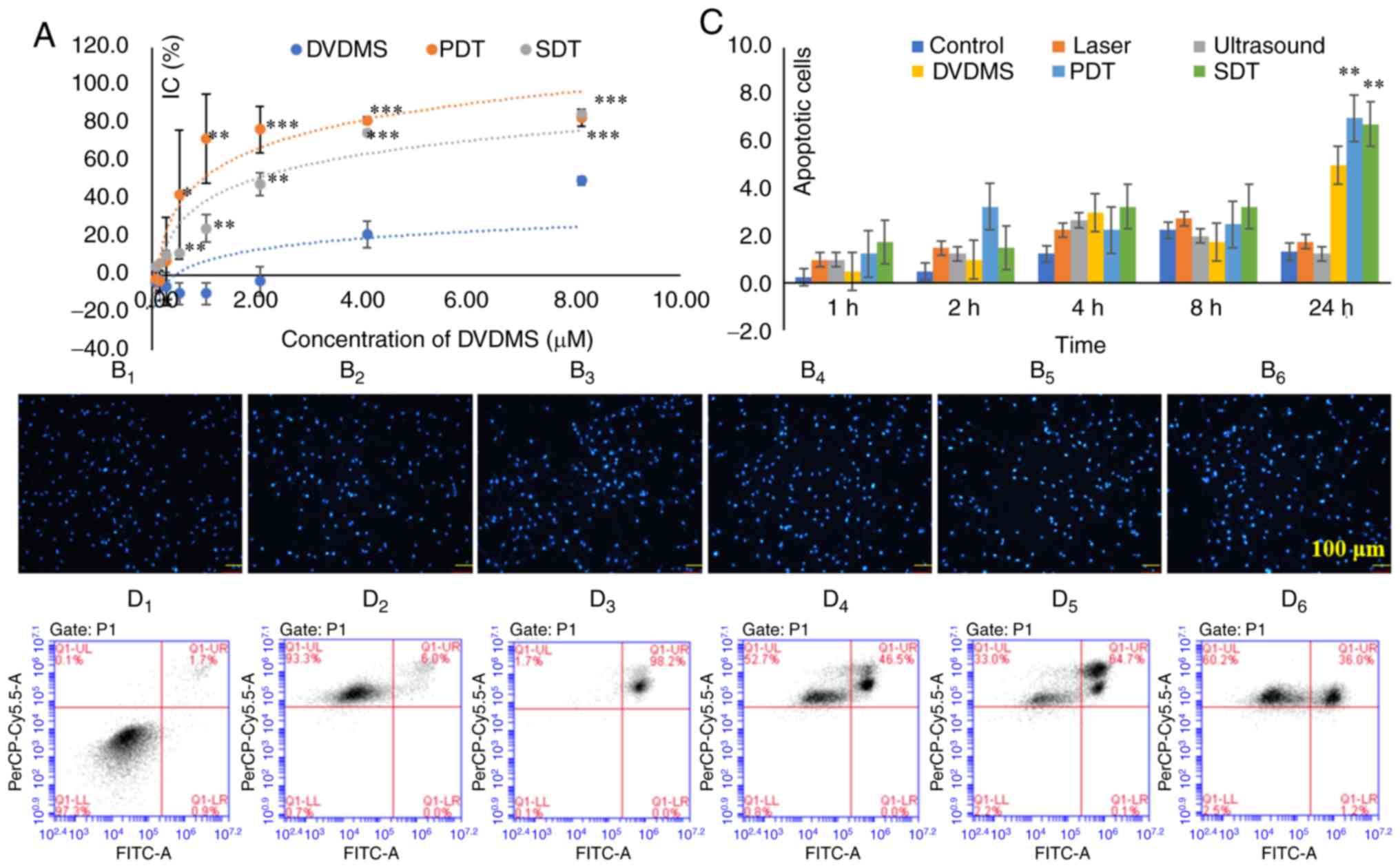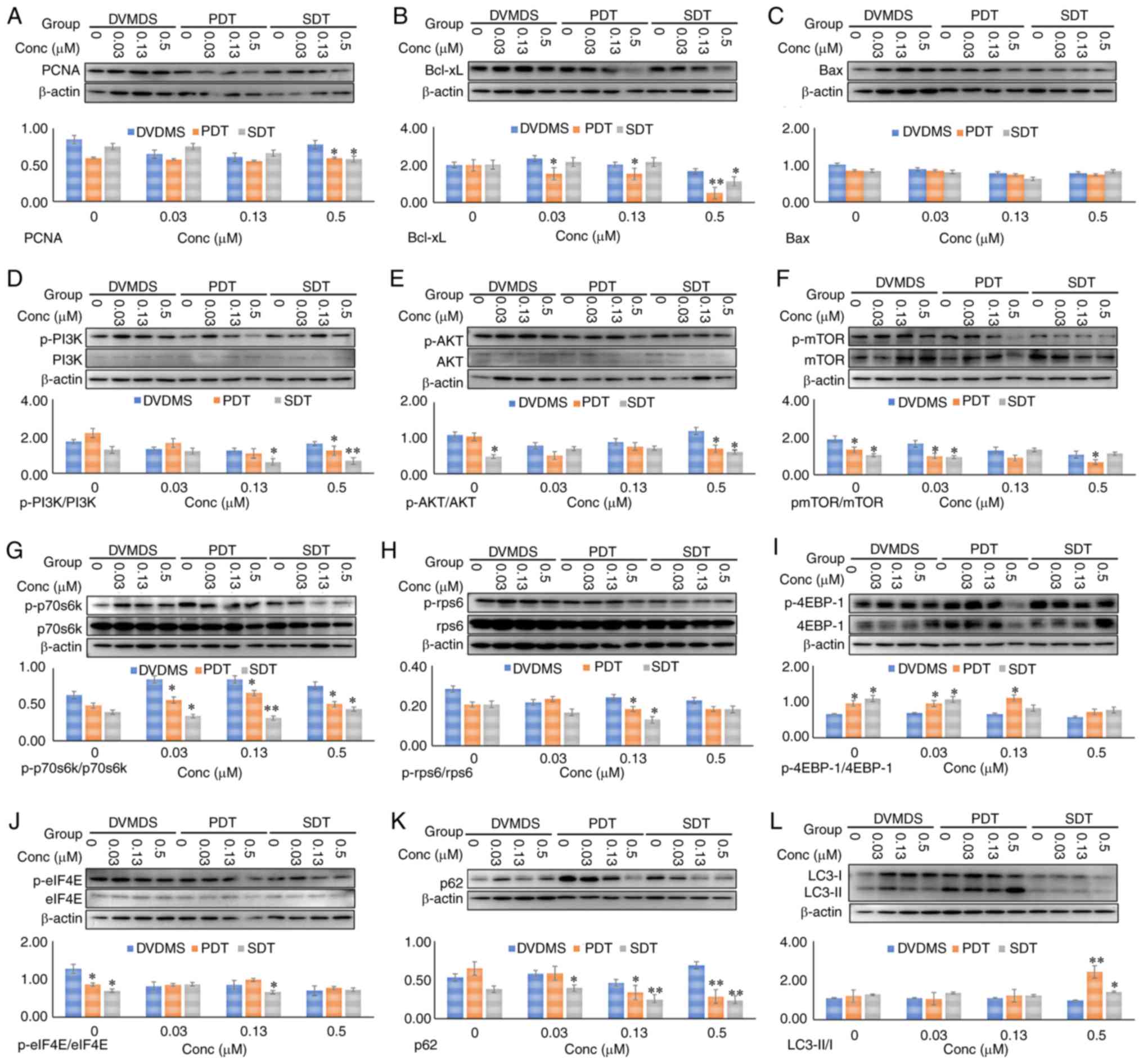|
1
|
Kwiatkowski S, Knap B, Przystupski D,
Saczko J, Kędzierska E, Knap-Czop K, Kotlińska J, Michel O,
Kotowski K and Kulbacka J: Photodynamic therapy-mechanisms,
photosensitizers and combinations. Biomed Pharmacother.
106:1098–1107. 2018. View Article : Google Scholar : PubMed/NCBI
|
|
2
|
Ang JM, Riaz IB, Kamal MU, Paragh G and
Zeitouni NC: Photodynamic therapy and pain: A systematic review.
Photodiagnosis Photodyn Ther. 19:308–344. 2017. View Article : Google Scholar : PubMed/NCBI
|
|
3
|
McHale AP, Callan JF, Nomikou N, Fowley C
and Callan B: Sonodynamic therapy: Concept, mechanism and
application to cancer treatment. Adv Exp Med Biol. 880:429–450.
2016. View Article : Google Scholar : PubMed/NCBI
|
|
4
|
Fitzmaurice S and Eisen DB: Daylight
photodynamic therapy: What is known and what is yet to be
determined. Dermatol Surg. 42:286–295. 2016. View Article : Google Scholar : PubMed/NCBI
|
|
5
|
Rkein AM and Ozog DM: Photodynamic
therapy. Dermatol Clin. 32:415–425. 2014. View Article : Google Scholar : PubMed/NCBI
|
|
6
|
Chilakamarthi U and Giribabu L:
Photodynamic therapy: Past, present and future. Chem Rec.
17:775–802. 2017. View Article : Google Scholar : PubMed/NCBI
|
|
7
|
Wang X, Jia Y, Wang P, Liu Q and Zheng H:
Current status and future perspectives of sonodynamic therapy in
glioma treatment. Ultrason Sonochem. 37:592–599. 2017. View Article : Google Scholar : PubMed/NCBI
|
|
8
|
Abrahamse H and Hamblin MR: New
photosensitizers for photodynamic therapy. Biochem J. 473:347–364.
2016. View Article : Google Scholar : PubMed/NCBI
|
|
9
|
Ibbotson SH: Adverse effects of topical
photodynamic therapy. Photodermatol Photoimmunol Photomed.
27:116–130. 2011. View Article : Google Scholar : PubMed/NCBI
|
|
10
|
Lin N, Li C, Wang Z, Zhang J, Ye X, Gao W,
Wang A, Jin H and Wei J: A safety study of a novel photosensitizer,
sinoporphyrin sodium, for photodynamic therapy in Beagle dogs.
Photochem Photobiol Sci. 14:815–832. 2015. View Article : Google Scholar : PubMed/NCBI
|
|
11
|
Shi R, Li C, Jiang Z, Li W, Wang A and Wei
J: Preclinical study of antineoplastic sinoporphyrin sodium-PDT via
in vitro and in vivo models. Molecules. 22:1122017. View Article : Google Scholar
|
|
12
|
Xiong W, Wang P, Hu J, Jia Y, Wu L, Chen
X, Liu Q and Wang X: A new sensitizer DVDMS combined with multiple
focused ultrasound treatments: An effective antitumor strategy. Sci
Rep. 5:174852015. View Article : Google Scholar : PubMed/NCBI
|
|
13
|
Liu Y, Wang P, Liu Q and Wang X:
Sinoporphyrin sodium triggered sono-photodynamic effects on breast
cancer both in vitro and in vivo. Ultrason Sonochem. 31:437–448.
2016. View Article : Google Scholar : PubMed/NCBI
|
|
14
|
Sun Q, Xu R, Xu H, Wang G, Shen X and
Jiang H: Extracranial metastases of high-grade glioma: The clinical
characteristics and mechanism. World J Surg Oncol. 15:1812017.
View Article : Google Scholar : PubMed/NCBI
|
|
15
|
McGranahan T, Li G and Nagpal S: History
and current state of immunotherapy in glioma and brain metastasis.
Ther Adv Med Oncol. 9:347–368. 2017. View Article : Google Scholar : PubMed/NCBI
|
|
16
|
Uhm JH and Porter AB: Treatment of glioma
in the 21st century: An exciting decade of postsurgical treatment
advances in the molecular era. Mayo Clin Proc. 92:995–1004. 2017.
View Article : Google Scholar : PubMed/NCBI
|
|
17
|
Long W, Yi Y, Chen S, Cao Q, Zhao W and
Liu Q: Potential new therapies for pediatric diffuse intrinsic
pontine glioma. Front Pharmacol. 8:4952017. View Article : Google Scholar : PubMed/NCBI
|
|
18
|
Zavadskaya ТS: Photodynamic therapy in the
treatment of glioma. Exp Oncol. 37:234–241. 2015. View Article : Google Scholar : PubMed/NCBI
|
|
19
|
Noske DP, Wolbers JG and Sterenborg HJ:
Photodynamic therapy of malignant glioma. A review of literature.
Clin Neurol Neurosurg. 93:293–307. 1991. View Article : Google Scholar : PubMed/NCBI
|
|
20
|
Hao D, Song Y, Che Z and Liu Q: Calcium
overload and in vitro apoptosis of the C6 glioma cells mediated by
sonodynamic therapy (hematoporphyrin monomethyl ether and
ultrasound). Cell Biochem Biophys. 70:1445–1452. 2014. View Article : Google Scholar : PubMed/NCBI
|
|
21
|
Nonaka M, Yamamoto M, Yoshino S, Umemura
S, Sasaki K and Fukushima T: Sonodynamic therapy consisting of
focused ultrasound and a photosensitizer causes a selective
antitumor effect in a rat intracranial glioma model. Anticancer
Res. 29:943–950. 2009.PubMed/NCBI
|
|
22
|
Halasi M, Wang M, Chavan TS, Gaponenko V,
Hay N and Gartel AL: ROS inhibitor N-acetyl-L-cysteine antagonizes
the activity of proteasome inhibitors. Biochem J. 454:201–208.
2013. View Article : Google Scholar : PubMed/NCBI
|
|
23
|
Song Y, Cho G, Suh JY, Lee CK, Kim YR, Kim
YJ and Kim JK: Dynamic contrast-enhanced MRI for monitoring
antiangiogenic treatment: Determination of accurate and reliable
perfusion parameters in a longitudinal study of a mouse xenograft
model. Korean J Radiol. 14:589–596. 2013. View Article : Google Scholar : PubMed/NCBI
|
|
24
|
Choi H, Gillespie DL, Berg S, Rice C,
Couldwell S, Gu J, Colman H, Jensen RL and Huang LE: Intermittent
induction of HIF-1alpha produces lasting effects on malignant
progression independent of its continued expression. PLoS One.
10:e01251252015. View Article : Google Scholar : PubMed/NCBI
|
|
25
|
Yu H and Xu L: Cell experimental studies
on sonoporation: State of the art and remaining problems. J Control
Release. 174:151–160. 2014. View Article : Google Scholar : PubMed/NCBI
|
|
26
|
Muleki Seya P, Fouqueray M, Ngo J, Poizat
A, Inserra C and Béra JC: Sonoporation of adherent cells under
regulated ultrasound cavitation conditions. Ultrasound Med Biol.
41:1008–1019. 2015. View Article : Google Scholar : PubMed/NCBI
|
|
27
|
Goodlad RA: Quantification of epithelial
cell proliferation, cell dynamics, and cell kinetics in vivo. Wiley
Interdiscip Rev Dev Biol. 6:2017. View Article : Google Scholar : PubMed/NCBI
|
|
28
|
Levesley J, Steele L, Brüning-Richardson
A, Davison A, Zhou J, Ding C, Lawler S and Short SC: Selective
BCL-XL inhibition promotes apoptosis in combination with MLN8237 in
medulloblastoma and pediatric glioblastoma cells. Neuro Oncol.
20:203–214. 2018. View Article : Google Scholar : PubMed/NCBI
|
|
29
|
Chen L, Liu P, Feng X and Ma C:
Salidroside suppressing LPS-induced myocardial injury by inhibiting
ROS-mediated PI3K/Akt/mTOR pathway in vitro and in vivo. J Cell Mol
Med. 21:3178–3189. 2017. View Article : Google Scholar : PubMed/NCBI
|
|
30
|
Lamark T, Svenning S and Johansen T:
Regulation of selective autophagy: The p62/SQSTM1 paradigm. Essays
Biochem. 61:609–624. 2017. View Article : Google Scholar : PubMed/NCBI
|
|
31
|
Jiang P and Mizushima N: LC3- and
p62-based biochemical methods for the analysis of autophagy
progression in mammalian cells. Methods. 75:13–18. 2015. View Article : Google Scholar : PubMed/NCBI
|
|
32
|
Hu J, Wang X, Liu Q, Zhang K, Xiong W, Xu
C, Wang P and Leung AW: Antitumor effect of sinoporphyrin
sodium-mediated photodynamic therapy on human esophageal cancer
Eca-109 cells. Photochem Photobiol. 90:1404–1412. 2014. View Article : Google Scholar : PubMed/NCBI
|
|
33
|
Yao J, Gao W, Wang Y, Wang L, Diabakte K,
Li J, Yang J, Jiang Y, Liu Y, Guo S, et al: Sonodynamic therapy
suppresses neovascularization in atherosclerotic plaques via
macrophage apoptosis-induced endothelial cell apoptosis. JACC Basic
Transl Sci. 5:53–65. 2019. View Article : Google Scholar : PubMed/NCBI
|
|
34
|
Shi Y, Zhang B, Feng X, Qu F, Wang S, Wu
L, Wang X, Liu Q, Wang P and Zhang K: Apoptosis and autophagy
induced by DVDMs-PDT on human esophageal cancer Eca-109 cells.
Photodiagn Photodyn Ther. 24:198–205. 2018. View Article : Google Scholar
|
|
35
|
Pi Z, Huang Y, Shen Y, Zeng X, Hu Y, Chen
T, Li C, Yu H, Chen S and Chen X: Sonodynamic therapy on
intracranial glioblastoma xenografts using sinoporphyrin sodium
delivered by ultrasound with microbubbles. Ann Biomed Eng.
47:549–562. 2019. View Article : Google Scholar : PubMed/NCBI
|
|
36
|
Liu H, Zhou M, Sheng Z, Chen Y, Yeh CK,
Chen W, Liu J, Liu X, Yan F and Zheng H: Theranostic
nanosensitizers for highly efficient MR/fluorescence imaging-guided
sonodynamic therapy of gliomas. J Cell Mol Med. 22:5394–5405. 2018.
View Article : Google Scholar : PubMed/NCBI
|
|
37
|
Sun Y, Wang H, Wang P, Zhang K, Geng X,
Liu Q and Wang X: Tumor targeting DVDMS-nanoliposomes for an
enhanced sonodynamic therapy of gliomas. Biomater Sci. 7:985–994.
2019. View Article : Google Scholar : PubMed/NCBI
|
|
38
|
Yan X, Niu G, Lin J, Jin AJ, Hu H, Tang Y,
Zhang Y, Wu A, Lu J, Zhang S, et al: Enhanced fluorescence imaging
guided photodynamic therapy of sinoporphyrin sodium loaded graphene
oxide. Biomaterials. 42:94–102. 2015. View Article : Google Scholar : PubMed/NCBI
|
|
39
|
Mai B, Wang X, Liu Q, Leung AW, Wang X, Xu
C and Wang P: The antibacterial effect of sinoporphyrin sodium
photodynamic therapy on Staphylococcus aureus planktonic and
biofilm cultures. Lasers Surg Med. 48:400–408. 2016. View Article : Google Scholar : PubMed/NCBI
|
|
40
|
Shi R, Lin X, Zhang J, Jin H, Wang A and
Wei J: Safety evaluation of repeated intravenous infusion of
sinoporphyrin with and without PDT in rats. Photochem Photobiol
Sci. 15:1366–1376. 2016. View Article : Google Scholar : PubMed/NCBI
|
|
41
|
Sun Y, Wang H, Zhang K, Liu J, Wang P,
Wang X and Liu Q: Sonodynamic therapy induces oxidative stress, DNA
damage and apoptosis in glioma cells. RSC Adv. 8:36245–36256. 2018.
View Article : Google Scholar
|
|
42
|
Wang X, Fu YF, Liu X, Feng G, Xiong D, Mu
GF and Chen FP: ROS promote Ox-LDL-induced platelet activation by
up-regulating autophagy through the inhibition of the PI3K/AKT/mTOR
pathway. Cell Physiol Biochem. 50:1779–1793. 2018. View Article : Google Scholar : PubMed/NCBI
|
|
43
|
Han XB, Li HX, Jiang YQ, Wang H, Li XS,
Kou JY, Zheng YH, Liu ZN, Li H, Li J, et al: Upconversion
nanoparticle-mediated photodynamic therapy induces autophagy and
cholesterol efflux of macrophage-derived foam cells via ROS
generation. Cell Death Dis. 8:e28642017. View Article : Google Scholar : PubMed/NCBI
|
|
44
|
Zheng L, Li Y, Li X, Kou J, Zhong Z, Jiang
Y, Liu Z, Tian Y and Yang L: Combination of hydroxyl acetylated
curcumin and ultrasound induces macrophage autophagy with
anti-apoptotic and anti-lipid aggregation effects. Cell Physiol
Biochem. 39:1746–1760. 2016. View Article : Google Scholar : PubMed/NCBI
|
|
45
|
Huang CI, Wang CC, Tai TS, Hwang TZ, Yang
CC, Hsu CM and Su YC: eIF4E and 4EBP1 are prognostic markers of
head and neck squamous cell carcinoma recurrence after definitive
surgery and adjuvant radiotherapy. PLoS One. 14:e02255372019.
View Article : Google Scholar : PubMed/NCBI
|
|
46
|
Reiners JJ Jr, Agostinis P, Berg K,
Oleinick NL and Kessel D: Assessing autophagy in the context of
photodynamic therapy. Autophagy. 6:7–18. 2010. View Article : Google Scholar : PubMed/NCBI
|
|
47
|
Xiong L, Liu Z, Ouyang G, Lin L, Huang H,
Kang H, Chen W, Miao X and Wen Y: Autophagy inhibition enhances
photocytotoxicity of Photosan-II in human colorectal cancer cells.
Oncotarget. 8:6419–6432. 2017. View Article : Google Scholar : PubMed/NCBI
|
|
48
|
Dewaele M, Martinet W, Rubio N, Verfaillie
T, de Witte PA, Piette J and Agostinis P: Autophagy pathways
activated in response to PDT contribute to cell resistance against
ROS damage. J Cell Mol Med. 15:1402–1414. 2011. View Article : Google Scholar : PubMed/NCBI
|
|
49
|
Li X, Zhang X, Zheng L, Kou J, Zhong Z,
Jiang Y, Wang W, Dong Z, Liu Z, Han X, et al: Hypericin-mediated
sonodynamic therapy induces autophagy and decreases lipids in THP-1
macrophage by promoting ROS-dependent nuclear translocation of
TFEB. Cell Death Dis. 7:e25272016. View Article : Google Scholar : PubMed/NCBI
|
|
50
|
Zhu B, Li S, Yu L, Hu W, Sheng D, Hou J,
Zhao N, Hou X, Wu Y, Han Z, et al: Inhibition of autophagy with
chloroquine enhanced sinoporphyrin sodium mediated photodynamic
therapy-induced apoptosis in human colorectal cancer cells. Int J
Biol Sci. 15:12–23. 2019. View Article : Google Scholar : PubMed/NCBI
|


















